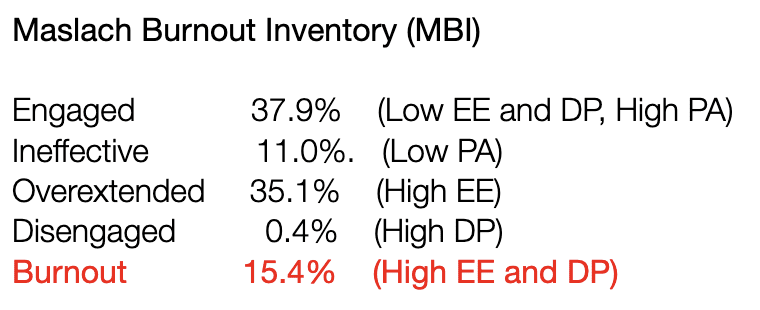Final Results of the 2023 NC Burnout Survey
(Dental Hygienists)
2023 NC Burnout Survey
September 25 through October 25, 2023
NC Dental Hygienists Sent Survey
7,740
NC Dental Hygienists Responded to Survey
319
Mind Garden (Burnout Survey Company) Comparison Dataset
> 6,300+ medical personnel
Understanding the Importance of Burnout
Burnout is a severe problem affecting medical personnel and healthcare organizations. New technologies, regulations, electronic health records, and increase market pressures are driving rapid change in the healthcare workplace. These changes to organizations and care delivery models impact how care is delivered and how it is experienced by patients. If the resulting work environment is not a good fit with physicians and other medical personnel, this can lead to staff burnout.
I. Maslach Burnout Inventory (MBI)
Emotional Exhaustion (EE). Feeling overwhelmed, stressed, and weary; the demands of the job feel far greater than one is able to give. An example item: “I feel emotionally drained from my work.”
Depersonalization (DP). Lost enthusiasm or an unfeeling, impersonal response towards the recipients of one’s care. The job feels like a burden or a chore. An example item: “I don’t really care what happens to some patients.”
Low Personal Accomplishment (PA). Feeling low levels of confidence and effectiveness, and not have a beneficial impact on people. An example item: “I have accomplished many worthwhile things in this job.”
Burnout has many personal costs including physical illness, increased feelings of hopelessness, irritability, impatience, poor interpersonal relationships with family/coworkers/patients, and drug abuse. In severe cases, burnout can cause diminished executive functioning, attention, and memory.
Burnout has many organizational cost including absenteeism, increased turnover, and decreased job performance. These consequences have a direct negative affect on patient safety, satisfaction, and quality of care.
Changing personal behaviors, managing exercise and sleep habits, and adding coping strategies such as yoga and meditation can help individuals develop resilience against burnout, but they do not address the areas of work that are actually causing the stress. Burnout prevention and remediation relies on meaningful organizational change.
Results for MBI
NC dental hygienists experienced higher emotional exhaustion and slightly less depersonalization while slightly less personal accomplishment as compared to the > 6,300 medical personnel dataset.

The profiles are described as Engaged, Ineffective, Overextended, Disengaged, and Burnout. People with different burnout profiles have different workplace experiences. As such, the interventions and methods used to ameliorate and prevent burnout may differ by profile. Please note: the profiles are provided to aid in score interpretation only and are not diagnostic.
A person with the Engaged profile scores well on all three scales: low on Emotional Exhaustion and Depersonalization, and high on Personal Accomplishment.
A person with the Ineffective profile has a low Personal Accomplishment score. The Ineffective profile is characterized by diminished feelings of competence and successful achievement in one’s work. This reflects a loss of confidence in one’s capabilities — perhaps as a result from work that feels tedious or an environment that offers little recognition for a job well done.
The Overextended person has a different psychological experience, shown by a high Emotional Exhaustion score. This might be the profile of a physician who is dedicated to her job and who derives a strong sense of accomplishment from her work, yet feels emotionally exhausted due to long work hours and disrupted recovery opportunities. This physician is fulfilled and involved, but emotionally drained.
The Disengaged profile features a high Depersonalization score which signals a crisis in values or diminished confidence in management. The disengaged person has energy and confidence in his competence, but finds it difficult to dedicate himself to his work.
While the previous three profiles are characterized by one problematic scale score, a person with the Burnout profile has problematic results on both Emotional Exhaustion and Depersonalization.
The most effective remedies to treat or prevent burnout will vary depending on the profile. For example, a person who fits the Overextended profile may be most responsive to workload-oriented interventions. By contrast, someone who fits the Disengaged profile may benefit more from interventions designed to improve social relationships among co-workers.
II. Six Areas of Worklife (AWS)
To address burnout, we must understand the work environment, or organizational context. The root causes for burnout are organizational problems and therefore the solution will come from deliberate organizational change. We look at six key areas to assess the fit between employees and the organization. A lack of fit, or a mismatch, between the employee and the organization can lead to burnout.
Workload: The amount of work to be done in a given time. A manageable workload provides the opportunity to do what one enjoys, to pursue career objectives, and to develop professionally. A crisis in workload is not just stretching to meet a new challenge, but going beyond human limits. An example item: “I do not have time to do the work that must be done.”
Control: The opportunity to make choices and decisions, to solve problems, and to fulfill job responsibilities. A good match has correspondence between control and accountability. A mismatch occurs when people lack sufficient control to fulfill their responsibilities. An example item: “I have control over how I do my work.”
Reward: Financial and social recognition for contributions on the job. A meaningful reward system acknowledges one’s contributions to work and clearly signals what is of value to the organization. People experience a lack of recognition as devaluing their work and themselves. An example item: “I receive recognition from others for my work.”
Community: The quality of an organization’s social environment and the positive connections between coworkers. People thrive in communities characterized by support, collaboration, and positive feelings. Mismatches occur when the employee does not have a positive connection with others at work. An example item: “Members of my work group communicate openly.
Fairness: The extent to which consistent and equitable rules apply to everyone, and that resources are allocated per generally understood and consistent procedures. Fairness communicates respect for the organization’s members. A lack of fairness indicates confusion in an organization’s values and its relationships with people. An example item: ‘Resources are allocated fairly here.”
Values: Values are what is most important to the individual and to the organization. When these values are congruent, successes are shared. Mismatches occur when there is a gap between the values of the individual and the values or actions of the organization. An example item: “My values and the organization’s values are alike.”
Results for AWS
Worklife Profile Percentages
Workload > Control = Community = Fairness > Values
Average Fit: Control > Workload > Community > Fairness > Values > Reward
Good Fit: Values > Fairness > Reward > Community > Workload > Control
Conclusions *
Contributing factors to increased burnout for NC Dental Hygienists include:
Rewards, Community, Fairness, and Values
Contributing factors to decreased burnout for NC Dental Hygienists include:
Workload, Control
* Conclusions are derived as compared to the > 6,300 medical personnel dataset from Mind Garden.
III. NC Dental Hygiene Questions & Challenges Results
- In 2023, how concerned are you about the overall direction organized dentistry is headed in the United States as a profession?
2. In 2023, how concerned are you about your overall future in dental hygiene in North Carolina?
3. Are you concerned about the increasing presence of “corporate-type” dental practices in North Carolina affecting the long-term sustainability of the current dental practice where you are primarily practicing?
4. Since May 2023 (“Post-Covid”), are you concerned you may have to cut back your hours, plan your retirement, or completely quit the practice of clinical dental hygiene?
5. At what level of concern do you have about maintaining a work-life balance?
Challenges
Clinical Practice

Administrative Practice

Personal








